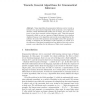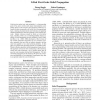90
Voted
ALT
2010
Springer
15 years 2 months ago
2010
Springer
Many algorithms for grammatical inference can be viewed as instances of a more general algorithm which maintains a set of primitive elements, which distributionally define sets of ...
109
click to vote
ECAI
2008
Springer
15 years 2 months ago
2008
Springer
This paper describes a novel method for explaining Bayesian network (BN) inference when the network is modeling a population of conditionally independent agents, each of which is m...
119
click to vote
CPAIOR
2008
Springer
15 years 2 months ago
2008
Springer
Theoretical models for the evaluation of quickly improving search strategies, like limited discrepancy search, are based on specific assumptions regarding the probability that a va...
FLAIRS
2007
15 years 3 months ago
2007
Symbolic reasoning is a well understood and effective approach to handling reasoning over formally represented knowledge; however, simple symbolic inference systems necessarily sl...
132
Voted
AAAI
2007
15 years 3 months ago
2007
In this paper, we consider a hybrid solution to the sensor network position inference problem, which combines a real-time filtering system with information from a more expensive,...
106
Voted
AAAI
2008
15 years 3 months ago
2008
Unifying first-order logic and probability is a long-standing goal of AI, and in recent years many representations combining aspects of the two have been proposed. However, infere...
84
Voted
AAAI
2008
15 years 3 months ago
2008
We propose a novel method for approximate inference in Bayesian networks (BNs). The idea is to sample data from a BN, learn a latent tree model (LTM) from the data offline, and wh...
80
Voted
AAAI
2008
15 years 3 months ago
2008
Compilation is an important approach to a range of inference problems, since it enables linear-time inference in the size S of the compiled representation. However, the main drawb...
EUROSSC
2009
Springer
15 years 3 months ago
2009
Springer
Abstract. In the domain of ubiquitous computing, the ability to identify the occurrence of situations is a core function of being ’contextaware’. Given the uncertain nature of ...
105
Voted
FGR
2004
IEEE
15 years 4 months ago
2004
IEEE
We present an algorithm for automatic inference of human upper body motion. A graph model is proposed for inferring human motion, and motion inference is posed as a mapping proble...


